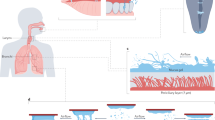Abstract
A theory is derived to calculate the regional and total deposition of aerosol particles in the nasal passages during inhalation. The particle size studied range from 0.2 to 10.0 μm diameter. The deposition is calculated in five regions; (I) the region filled with nasal hair, (II) the nasal valve, (III) the expansion region, (IV) the turbinate region and (V) the posterior bend. Equations are derived to determine the deposition caused by direct impaction on the nasal hairs and bends of the passages. The calculations show the deposition due to direct impaction does not account for the amount or location of deposited particles measured in experiments. Secondary flows have been speculated to exist in the expansion region after the nasal valve and an equation is derived to estimate the deposition caused by the secondary flows. The calculated deposition, due to direct impaction and secondary flows, shows general agreement with the experiment as to the predicted amount and location of deposited particles.
Similar content being viewed by others
Literature
Bilgen, E., P. Arbour and P. T. Turik. 1974. “On the Resistance of Air Flow Through the Nose.” ASME Publication, United Engineering Center, N.Y..
Bridger, P. 1970. “Physiology of the Nasal Valve.”Arch. Otolarny,92, 543–553.
Davies, C. N. 1973.Air Filtration, pp. 17–28. London: Academic Press.
Foss, J. F. and J. B. Jones. 1968. “Secondary Flow Effects in a Bounded Rectangular Jet.”J. Basic Engng,90, 241–248.
Fry, F. A. and A. Black. 1973. “Regional Deposition and Clearance of Particles in the Human Nose.”J. Aerosol Science,4, 113–124.
Giacomelli-Maltoni, G. C., C. Melandri, V. Prodi and G. Tarroni. 1972. “Deposition Efficiency of Monodisperse Particles in the Human Respiratory Tract.”Am. J. Indust. Hyg.,33, 603–610.
Heyder, J. and G. Rudolph. 1975 “Deposition of Aerosol Particles in the Human Nose.” Paper presented at the Fourth International Symposium on Inhaled Particles and Vapors, Edinburgh.
Hounam, R. F., A. Black and M. Walsh. 1971. “The Deposition of Aerosol Particles in the Nasopharynegeal Region of the Human Respiratory Tract.”Inhaled Particles, III. Ed. W. H. Walton. pp. 71–80, Vol. I. Gresham Press.
Hydraulic Institute. 1961.Pipe Friction Manual. Hydraulic Institute, N.Y.
Jones, J. G., S. W. Clarke and D. R. Oliver. 1969. “Two-phase Gas-Liquid Flow in Airways.”Br. J. Anasthesia,41, 192–193.
Landahl, H. D. 1950. “On the Removal of Air-borne Droplets by the Human Respiratory Tract: II. The Nasal Passages.”Bull. Math. Biophys.,12, 161–169.
Landahl, H. D. and S. Black. 1947. “Penetration of Airborne Particulates Through the Human Nose.”J. Indust. Hyg. Toxicol.,29, 269–277.
Landahl, H. D. and T. Tracewell. 1949. “Penetration of Air-borne Particulates through the Human Nose: II.”J. Indust. Hyg. Toxicol.,31, 55–59.
Lippman, Morton. 1970. “Deposition and Clearance of Inhaled Particles in the Human Nose.”Ann. Otology, Rhinology Laryndogy,76, 519–528.
Liu, B. Y. H. and J. K. Agarwal. 1974. “Experimental Observation of Aerosol Deposition in Turbulent Flow.”J. Aerosol Sci.,5, 145–155.
Milne-Thomson, L. M. 1938.Theoretical Hydrodynamics, pp. 256–269. London: MacMillan and Co.
Pattle, R. E. 1961. “The retention of Gases and Particles in the Human Nose.”Inhaled Particles and Vapours. Ed. C. N. Davies. pp. 302–311. Pergamon Press.
Proctor, D. F. and D. L. Swift. 1971. “The Nose—A Defense against the Atmospheric Environment.”Inhaled Particles III, Vol. 1. Ed. W. H. Walton, pp. 50–70. Gresham Press.
Proctor, D. F. and N. H. Wagner. 1967. “Mucociliary Particle Clearance in the Human Nose.”Inhaled Particles and Vapours, II. Ed. by C. N. Davies. pp. 25–35. Pergamon Press.
Proetz, A. W. 1953.Applied Physiology of the Nose. pp. 119–169. St. Louis: Annals Publishing Company.
Schlichting, H. 1966.Boundary Layer Theory. New York: McGraw Hill Book Company.
Task Group on Lung Dynamics, Committee II of the International Commission on Radiological Protection, 1966. “Deposition and Retention Models for Internal Dosimetry of the Human Respiratory Tract.”Hlth Phys.,12, 173–207.
Yeh, H. C. 1974. “Use of a Heat Transfer Analogy for a mathematical Model of Respiratory Tract Deposition.”Bull. Math. Biol.,36, 105–116.
Author information
Authors and Affiliations
Rights and permissions
About this article
Cite this article
Scott, W.R., Taulbee, D.B. & Yu, C.P. Theoretical study of nasal deposition. Bltn Mathcal Biology 40, 581–604 (1978). https://doi.org/10.1007/BF02460732
Received:
Revised:
Issue Date:
DOI: https://doi.org/10.1007/BF02460732




